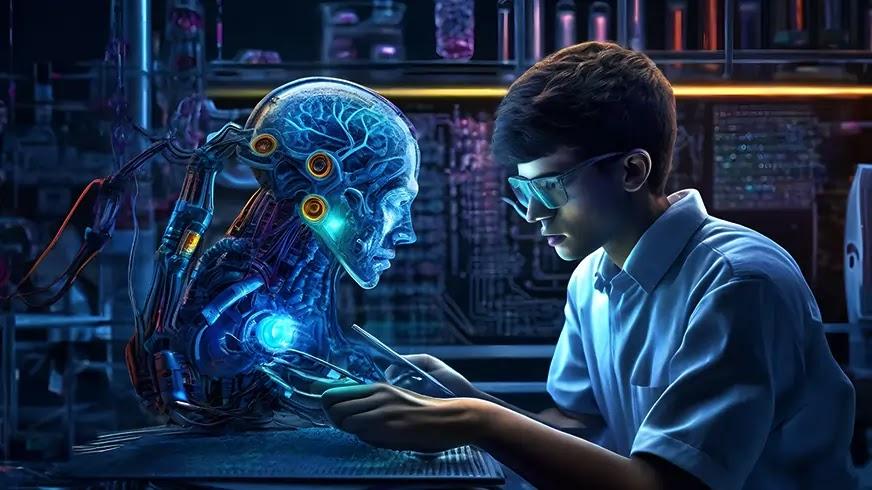Understanding the Rise of Generative Artificial Intelligence

What is Generative AI?
Generative artificial intelligence (AI) refers to a class of machine learning algorithms that are able to generate new data that's coherent and self-consistent. Instead of just recognizing patterns in existing data, generative models can learn the underlying structure or distribution in the training data and use it to synthesize new examples that resemble the original samples. Some common forms of generative AI include generative adversarial networks (GANs) for image generation, sequence-to-sequence models for language generation, and variational autoencoders (VAEs) for representation learning.
GANs Revolutionize Image Generation
One of the most influential generative models is the GAN, proposed in 2014. GANs utilize a generative model and a discriminative model that compete against each other in a game theoretic setup. The Generative AI model, called the generator, captures the data distribution to generate new artificial examples which resemble the training data. The discriminative model, called the discriminator, evaluates how well the generator's samples match the real data distribution. This adversarial training process pushes the generator to produce outputs that get closer to the real data distribution with each iteration. Over the past few years, GANs have advanced computer vision with capabilities like image editing, super resolution, photo enhancement, and image-to-image translation. GANs can now generate realistic fake photos and videos that are nearly indistinguishable from real ones.
Natural Language Generation Technologies Emerge
While image generation using deep learning took off with GANs, language generation proved more challenging initially due to the discrete nature of text. Recurrent neural networks (RNNs) were commonly used for language modeling to predict the next word based on preceding context. However, the earliest RNN language models suffered from issues like exposure bias during training and problems retaining long-term dependencies. The advent of attention mechanisms and transformer architectures helped address these concerns and led to state-of-the-art language models like GPT-3 with over 175 billion parameters. Modern text generation models can produce realistic fake news stories, product reviews, essays, and even code. However, dangers arise from "deepfake text" used for fake reviews, phishing scams, and spreading misinformation at scale. Researchers are actively working on techniques to ensure safe, responsible, and beneficial use of generative language models.
Multimodal AI Generates Images from Text Descriptions
Given the success of GANs in computer vision and transformer models in natural language processing, the next frontier is building AI systems that understand and generate across multiple modalities like text, images, audio, and video. Multimodal models aim to learn joint representations and translate between different forms of data. Projects like DALL-E by OpenAI can generate realistic images conditioned on text descriptions by leveraging large language models pretrained on billions of web pages. Commercial tools like Anthropic's Constitutional AI platform utilize techniques like self-supervision and alignment to ensure AI systems stay beneficial during multimodal generation tasks. Looking ahead, the potential for AI to automatically generate multimedia stories, movies, and virtual experiences from natural language prompts alone is tremendously exciting as well as prone to potential abuse if left unconstrained.
Progress in AI Music and Art Generation
While generative models started with stylized doodles, advances enabled synthesizing photographs, illustrations, and digital paintings that emulate artistic styles. Music generation has diversified from simple repetition to composing full songs indistinguishable from human works. AI can analyze musical structure, chord progressions, and tone to produce original songs spanning genres. Companies like Jukedeck use machine learning to autonomously create copyright-free background music tailored to websites and videos. However, debates persist around defining ownership, attribution, and monetization of AI-generated creative works. Researchers are exploring ways AI can enhance rather than replace human artists by serving as collaborative tools. Despite making great strides, generative models still fail to capture the subtle nuances, emotion, and deeper meaning conveyed through human creativity.
The March Towards Artificial General Intelligence?
While today's AI systems are specialized narrow tools, the long term vision pursued by some leading firms involves developing human-level or super-human artificial general intelligence (AGI). AGI refers to an AI capable of understanding or learning any intellectual task that a human can. The ability to generate and understand complex multimodal data at scale using self-supervised learning from web-scale text and images has led some experts to believe that we may be on the path to developing increasingly general models. However, other AI safety researchers caution that we are still far away from machines with human-level judgment, common sense, and general problem solving capabilities. The ethical challenges surrounding AGI development could have existential consequences if not addressed proactively through principles of safety, oversight and accountable policymaking aligned with upholding societal values as progress continues.
Balancing Pros and Cons of Generative AI Responsibly
Generative AI holds immense potential for positive application across domains like healthcare, education, business and entertainment if developed responsibly. However, dangers also arise from its capacity for misuse through deception, intellectual property harms, dissemination of misinformation, and risks surrounding technological unemployment. Researchers are actively exploring techniques like constitutional AI, self-supervised learning, model oversight and transparency to ensure the safe, ethical and beneficial development of generative capabilities. Going forward, interdisciplinary collaboration between technologists, policymakers, social scientists and domain experts will be vital to balance generative AI's pros and cons through principles of transparency, accountability, oversight and human values alignment as this revolutionary class of algorithms continues pushing the boundaries of what's possible with artificial intelligence.
Get This Report in Japanese Language -ジェネレーティブAI市場
Get This Report in Korean Language -생성형 AI 시장
About Author:
Vaagisha brings over three years of expertise as a content editor in the market research domain. Originally a creative writer, she discovered her passion for editing, combining her flair for writing with a meticulous eye for detail. Her ability to craft and refine compelling content makes her an invaluable asset in delivering polished and engaging write-ups.
(LinkedIn: https://www.linkedin.com/in/vaagisha-singh-8080b91)
Categories
Read More
YouTube to MP3 conversion has turned into a popular practice among internet users who need to extract audio from YouTube videos for various purposes, such as playing music offline, creating playlists, or using audio clips in their own content creations. This technique involves using specialized tools or software to convert the audio portion of a YouTube video into an MP3 file format, which will...

The Halogen-Free Flame Retardant market research report, as published by Market Insight Reports, provides insights into the current global outlook and key regions, examining Major Players, Countries, Product Types, and end industries. It focuses on top players in the global market and categorizes the market based on several parameters. This Halogen-Free Flame Retardant market research...



